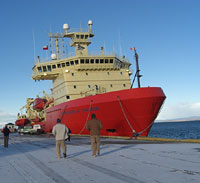

 | |||||||||||||||
|
|
Journals 2008/2009Roy Arezzo
July 10, 2008 I went to sleep in summer and woke to winter. My journey started on Saturday, July 5, 2008; a long trip to the tip of South America from New York City. I arrived on July 6 and met the science teams from warm locations, North Carolina State and University of Hawaii, for a warm reception in the cold landscape of Punta Arenas, Chile.
The next few days found us all working the back deck and labs of the RVIB NATHANIEL B. PALMER, looking more like contractors than scientists. In our Raytheon issued work gear wielding power tools, we prepped, rigged, float tested, loaded, stowed and secured science equipment designed to sample the world at 600 meters below the icy sea surface. The sister vessel, the Laurence M.Gould, pulled in with stories of high seas and stormy weather. The freezing temperatures, short days and small squalls of snow here in Punta Arenas remind us all that we are going someplace that can be very inhospitable.
On our cruise we will mainly investigate the nutrient cycling between pelagic Antarctic zones and the benthic communities below. To do this we will take samples from five points along a transect extending south from Smith Island (63° S) to Marguerite Bay (68° S), a little more than 300 miles along the Antarctic Peninsula. Project FOODBANCS2, out for its second cruise, is a joint effort of Dr. Craig R. Smith a biologist from University of Hawaii and Dr. David J. DeMaster, and Dr. Carrie J. Thomas, geochemists from North Carolina State. Since the poles are more greatly impacted by global climate change, with the Antarctic Peninsula and surrounding ice shelf showing signs of degradation, this is the place to study the warming affects on marine communities. The deepwater ecosystems here tend to show less seasonal variation and this smoothing effect provides an excellent lens to view impacts from warming. To test these changes there is a healthy team of scientists aboard sampling various parameters, including but not limited to, species structure and biodiversity in plankton and seafloor communities. We will look at live organism's gut contents, ID plankton and measure organic carbon recycling in sediments to name just a few of the tasks to look forward to. Once we reach our study sites there will be around-the-clock sampling from all layers of the water.
Although I have spent much of my work hours donning a hardhat to help load and offload equipment from the back deck by crane - my contribution to science has been helping to build and test the underwater camera gear. Specifically, we assembled two frames and mooring chains with a plan to deploy time-lapse camera systems. They will record changes in the benthic (seafloor) zone at the most northern and southern points of our transect line. The cameras operate with a digital lens, strobe lights and computer circuits designed to take an image every 12 hours for up to seven months. The set-up involves balancing floats and weights so that the camera stays in position on the seabed floor. The images will show evidence of the critters that live at depth and the build up of detritus, the snowfall of organic matter from above, which these organisms rely on for food.
Today we shipped out and I stood in the bow as we left port into the Strait of Magellan, saying goodbye to Chile and Argentina, and headed around the horn and south to the ice. We are all excited for what lies ahead. For more about the project check back often or visit our research blog at http://uhmanoa-antarctic-research.blogspot.com/ |
||||||||||||||


